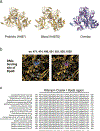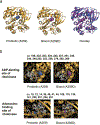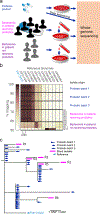Genomic and epidemiological evidence of bacterial transmission from probiotic capsule to blood in ICU patients
- PMID: 31700189
- PMCID: PMC6980696
- DOI: 10.1038/s41591-019-0626-9
Genomic and epidemiological evidence of bacterial transmission from probiotic capsule to blood in ICU patients
Abstract
Probiotics are routinely administered to hospitalized patients for many potential indications1 but have been associated with adverse effects that may outweigh their potential benefits2-7. It is particularly alarming that probiotic strains can cause bacteremia8,9, yet direct evidence for an ancestral link between blood isolates and administered probiotics is lacking. Here we report a markedly higher risk of Lactobacillus bacteremia for intensive care unit (ICU) patients treated with probiotics compared to those not treated, and provide genomics data that support the idea of direct clonal transmission of probiotics to the bloodstream. Whole-genome-based phylogeny showed that Lactobacilli isolated from treated patients' blood were phylogenetically inseparable from Lactobacilli isolated from the associated probiotic product. Indeed, the minute genetic diversity among the blood isolates mostly mirrored pre-existing genetic heterogeneity found in the probiotic product. Some blood isolates also contained de novo mutations, including a non-synonymous SNP conferring antibiotic resistance in one patient. Our findings support that probiotic strains can directly cause bacteremia and adaptively evolve within ICU patients.
Conflict of interest statement
Competing Interests Statement
The authors have no competing interests as defined by Nature Research, or other interests that might be perceived to influence the interpretation of the article.
Figures







Comment in
-
Balancing the risks and rewards of live biotherapeutics.Nat Rev Gastroenterol Hepatol. 2020 Mar;17(3):133-134. doi: 10.1038/s41575-019-0254-3. Nat Rev Gastroenterol Hepatol. 2020. PMID: 31873192 No abstract available.
References
-
- Szajewska H What are the indications for using probiotics in children? Arch. Dis. Child 101, 398–403 (2016). - PubMed
-
- Barraud D, Bollaert P-E & Gibot S Impact of the administration of probiotics on mortality in critically ill adult patients: a meta-analysis of randomized controlled trials. Chest 143, 646–655 (2013). - PubMed
-
- Barraud D et al. Probiotics in the critically ill patient: a double blind, randomized, placebo-controlled trial. Intensive Care Med. 36, 1540–1547 (2010). - PubMed
-
- Honeycutt TCB et al. Probiotic administration and the incidence of nosocomial infection in pediatric intensive care: a randomized placebo-controlled trial. Pediatr. Crit. Care Med. 8, 452–8; quiz 464 (2007). - PubMed
Publication types
MeSH terms
Grants and funding
LinkOut - more resources
Full Text Sources

